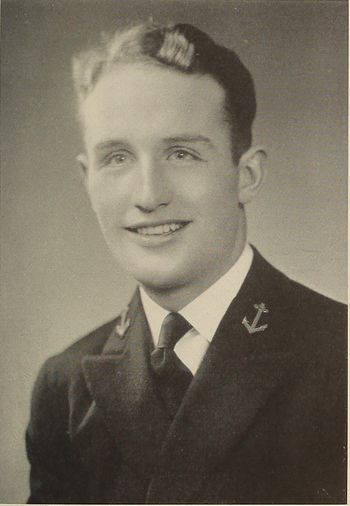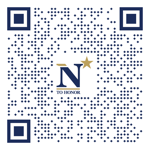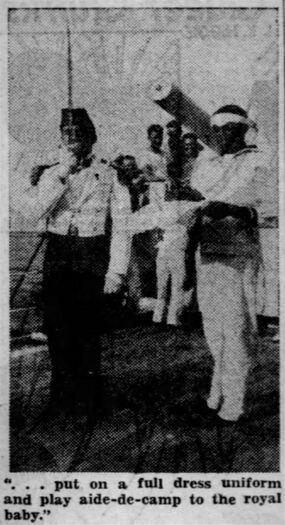IRVING G. MCCANN, JR., LT, USN
Irving McCann, Jr. '35
Lucky Bag
From the 1935 Lucky Bag:
IRVING GOFF McCANN, JR.
Casper, Wyoming
"Cowboy" "Bronco" "Kick" "Iggy"
A WESTERN mustang in the harness of Eastern society! Out of the West came his ideals. The East polished and refined the raw material. Still, the product is as open-minded as the plains are broad, and has a will and determination as steady as Independence Rock. He is earnest and enthusiastic about everything that interests him. People fascinate and entertain him; as a mixer and introducer, his hat is in the ring. He always drags; and who? From an egocentric sphere, discipline and routine lifted his mind to a world panorama. In him, the sensual and the common place yield to the imaginative and intellectual. He shows cosmopolitan adaptation, at home or anywhere, and is a man among men, but a gentleman!
Boxing 4, 3, 2, NA. Class Boxing 1. Outdoor Rifle 4, 2, 1. Quarterdeck Society 2, 1. Reception Committee 3. M.P.O.

IRVING GOFF McCANN, JR.
Casper, Wyoming
"Cowboy" "Bronco" "Kick" "Iggy"
A WESTERN mustang in the harness of Eastern society! Out of the West came his ideals. The East polished and refined the raw material. Still, the product is as open-minded as the plains are broad, and has a will and determination as steady as Independence Rock. He is earnest and enthusiastic about everything that interests him. People fascinate and entertain him; as a mixer and introducer, his hat is in the ring. He always drags; and who? From an egocentric sphere, discipline and routine lifted his mind to a world panorama. In him, the sensual and the common place yield to the imaginative and intellectual. He shows cosmopolitan adaptation, at home or anywhere, and is a man among men, but a gentleman!
Boxing 4, 3, 2, NA. Class Boxing 1. Outdoor Rifle 4, 2, 1. Quarterdeck Society 2, 1. Reception Committee 3. M.P.O.
Loss
Irving was lost when USS Vincennes (CA 44) was sunk early in the morning of August 9, 1942 by Japanese surface forces at the Battle of Savo Island.
Other Information
From A Log of the Vincennes:
Lieutenant McCann was born on September 3, 1913, at Gasper, Wyoming. He was appointed Midshipman on June 11, 1931, and was graduated from the Naval Academy, June 6, 1935. During the period between June, 1935, and May, 1938, he served on board the U.S.S. Tuscaloosa and the U.S.S. Cuyama. On August 9, 1938, he was commissioned Lieutenant (jg) to rank from June 6 of that year. He served on board the U.S.S. Haraden from December 18, 1938, to September 24, 1940. He was then assigned to the Vincennes, to which he reported for duty on October 8, 1940. Like other officers of his ship, he was promoted after the Battle of Midway, being commissioned Lieutenant (sg) to rank from June 15, 1942. He was reported missing in action against the enemy in the Battle of Savo Island. He was unmarried. His mother, Mrs. Roy Sands McCann, writes from Aptos, California.
From researcher Kathy Franz:
In April 1929, Irving lost on a technical knockout in the second round in the Elks amateur boxing tournament. The decision "brought many booes from the crowd that continued for sometime after the two-to-one verdict had been given. It was the opinion of many fans that McCann carried the fight all the way and should have received the decision."
Irving attended Natrona County High School. He was a member of the first Debate chapter of the National Forensic league in April 1930. He received a C pin from his debate coach, Miss Frances Ferris. (In 1952 the Irving G. McCann, Jr., trophy for excellence in forensics was instituted at his school. In March 1957 at a Kiwanis luncheon, Miss Ferris remembered Irving and two others who were outstanding debate students and who died in WWII.) On May 16, 1930, he was an entrant in the annual Cromer oratorical contest. In his senior year, he was elected editor of the Euclid club paper, the Euclidean. He graduated mid-year from Natrona County High School but was awarded in June 1931 the coveted "C" pin conferred by the Fort Casper chapter of the Daughters of the American Revolution for high scholastic standards. He also participated in a number of high school plays, was a captain in the cadet corps during his senior year, a member of the National Honor society and the mathematics club, The Euclid, and a member of the National Guard troop for two years.
He was appointed to the Naval Academy by Congressman Vincent E. Carter of Wyoming and Senator John B. Kendrick.
Irving's father was a local attorney who served in the Illinois infantry, did a tour at the Mexican border, and wrote the book "With the National Guard on the Border." His mother was an artist whose landscape paintings were displayed in a Denver art gallery. His sisters were Maurine, Virginia, and Sarah who was also on the high school debate team.
From the Casper Tribune-Herald 1935, in a letter written to the paper by Irving:
"The day I joined the U.S.S. Tuscaloosa, which is at this time the newest cruiser in the fleet, I was assigned to the engineering department as a division officer and junior watch officer. Of all the divisions on a ship the 'A' or auxiliary division is the most mixed up. It includes compartments and machinery all over the ship. From the gasoline tanks in the bow to the shaft alleys back aft one finds 'A' division equipment which includes such things as the evaporators, the ice machines, the blacksmith shop, the motor boat engines, the tool room, the machine shop and a lot more. For a few weeks, at least, I admit that I was quite bewildered. And worried, too, because I felt that I didn't know as much about everything as I should.
"During the summer cruise to northern waters we were frightfully short of officers. Two factors contributed to make this the case. First, the complement of both officers and men on all ships has been reduced to the minimum. Secondly, several of the officers were temporarily detached for the summer to attend gunnery school.
"On the way from Long Beach to Seattle we engaged in tactical exercises. One of the first things on the schedule was a night destroyer attack. It was to be a surprise attack, so no one knew just what time of the night it would be launched. The guns and control stations were manned for hours. Men strained their eyes peering into the blackness of the night in an effort to pick up strange shapes which might be destroyers creeping in to deliver their attack under the protection of darkness. At last, they came in. And when they did I found myself doing six things at once. There I was controlling the port secondary battery and search lights. With signal controls in both hands, a telephone in front of my face, and earphones strapped on my head I was receiving orders, repeating orders, and trying to co-ordinate the work of those around me. It only lasted a few minutes, but by the time it was over I was in a cold sweat.
"Our visits to Seattle, Tacoma and Port Angeles were all interesting. One of the young aviators went to a party given in honor of 'Miss Seattle.' Shortly afterwards we had 'Miss Seattle' and all of her 'court' out to the ship for dinner. A grand time was had by all. While we were in Tacoma I almost missed going up to Ranier National park. Anyone who has a chance to make that trip and misses it is really missing something if he enjoys beautiful scenery. The great northwest is in many respects a scenic paradise. Amidst the new and rapidly growing developments up there one feels and sees a heritage from the Redman. Every town has its totem pole and collection of Indian relics and legends.
"The international ball given by the city of Seattle for the officers of the Canadian and United States ships was a grand affair. Later in the summer at San Francisco and San Diego navy balls were given in our honor. Incidentally, in San Francisco, the navy ball was given at the Fairmont hotel, where Frank M. Turner, who graduated from high school in Casper in '29 and later from Cornell, is assistant manager. I should not be surprised if he was the youngest assistant manager of a hotel the size of the Fairmont in this country.
"Just now I'm on the U.S.S. Argonne, base force flagship, for temporary duty with the fleet camera party. A couple of weeks ago we went out on the radio-controlled target ship Utah for a week's work. This week we came out from San Pedro on the destroyer Talbot, shifted to the radio-controlled destroyer Boggs, and then, after a couple of days' work shifted to the U.S.S. Nevada for transportation back to San Pedro. Believe you me, it's a ticklish job taking a couple of tons of gear from a small boat via a rope to a destroyer when both ships are rolling and pitching. The other night I took a party of men over to the U.S.S. Mississippi for the night. We got aboard her about 11:30 in the evening and had to get up at 4:30 in order to get back on the Boggs in time to let her get under way as scheduled.
"My naval academy roommate is here on the Nevada. He's one of these very brilliant young men. Since Ray can do almost anything he's quite sought after when it comes to doing a job that includes much figuring, especially if it happens to be some new task for which there is no method of attack. Shortly after he reported aboard he was sent to optical school. Now he's range finder and optical officer on this Battle Wagon. Within a year or so he hopes to go to M. I. T., learn how to make ships, and then get into the construction corps of the navy.
"If this letter is of any interest to you I hope to have a chance to write again some time soon. Enclosed you will find a check for a three-months' subscription to the Casper Tribune. Since my old subscription ran out I've missed news about the old home town quite a lot."
From Casper Star-Tribune on December 15, 1936:
Becomes 'Shellback'
Irving G. McCann, Jr., formerly of Casper and now an ensign on board the U.S.S. Tuscaloosa, was recently initiated into the "Majestic Mysteries of the Ancient and Royal Order of the Deep," he reported in a letter to the Tribune-Herald.
[In an earlier article, Irving said: "They say, unfortunately, that this ship is contaminated by the presence of land lubbers, sand crabs, ground hogs, mud hens, cake eaters, bar flies, shieks, gigolos, and pollywogs. In order to remedy this deplorable situation and rid this good ship of these vacillating vermin His Royal Highness (Neptunus Rex) has to come aboard and initiate these invertebrate creatures into the 'Royal Order of the Deep,' thus making deep sea sailors out of what were before disreputable land lubbers!"]
The initiation ceremony, performed upon crossing the equator for the first time, makes McCann a "deep-sea sailor" or "shellback." Both officers and enlisted men undergo the initiation at the same time as the equator is crossed.
To start the initiation as a shellback, a safety committee is appointed to see that nothing is planned which might result in injuries to anyone. The afternoon before the initiation day, all officers to be initiated must wear some special regalia to receive the "royal party" which supposedly comes on board. The costumes included fur-lined winter flying togs, a deep-sea diving outfit, full dress uniforms, and similar clothing.
"Someone must have let me off easy, for all I had to do was put on a full dress uniform and play aide-de-camp to the royal baby. In the enclosed photo my room-boy, standing behind me, has a canteen of Coca Cola on a tray, which I was obliged to bring along for the royal baby, McCann wrote."
That evening the "pollywogs" were put in stocks, and spent most of the night in jail. In the morning they were served "salt horse" (corned beef) and "hard tack" (Biscuit), both served cold. The remaining part of McCann's initiation consisted of having his hair clipped by amateur barbers and being ducked in a tank of water until he said "Shellback."
The Tuscaloosa, a 10,000-ton heavy cruiser put into commission in 1934, recently made a trip to Peru. McCann writes, "While there in Peru I received the impression that the Japanese, the English and the Germans have gotten the jump on us where different things are concerned. However, I was delighted to see that practically all of the automobiles were of American make, and our motion pictures are very popular . . .
"One of the officials from the embassy said that we had done more to promote good feelings and friendly relations during our brief visit that they could do in ten years time. Realizing that this is a very flattering remark and also that the members of our foreign service are very modest about their fine work, I still think this remark bears a moment's consideration. Despite our interest in and our proximity to South America, our visit was the first in almost 20 years that American warships had made to Peru. Apparently the British and German governments realize that both friendly relations and commercial interests can be helped by visiting men-of-war. The British have a ship or ships in South American waters almost the year around. I have been told that they seem to make a practice of visiting all the important ports about once a year. And the German navy, small as it is, seems to have a ship or two cruising around the world all the time, touching one port after another.
"We put on a parade in Lima and you should have seen the crowds that turned out to watch it. For at least two hours before the parade passed, the sidewalks and intersections were crowded with people. When the parade was going by the central plaza of Lima, the sidewalks in front of the hotel were jammed with people . . .
"I want you to know how much I appreciate the Casper Tribune-Herald, I particularly like to keep up with the general trend of things around home. Yes, home, despite the fact that it has been almost six years since I left there for Annapolis."
His mother was listed as next of kin.
Photographs
The "Register of Commissioned and Warrant Officers of the United States Navy and Marine Corps" was published annually from 1815 through at least the 1970s; it provided rank, command or station, and occasionally billet until the beginning of World War II when command/station was no longer included. Scanned copies were reviewed and data entered from the mid-1840s through 1922, when more-frequent Navy Directories were available.
The Navy Directory was a publication that provided information on the command, billet, and rank of every active and retired naval officer. Single editions have been found online from January 1915 and March 1918, and then from three to six editions per year from 1923 through 1940; the final edition is from April 1941.
The entries in both series of documents are sometimes cryptic and confusing. They are often inconsistent, even within an edition, with the name of commands; this is especially true for aviation squadrons in the 1920s and early 1930s.
Alumni listed at the same command may or may not have had significant interactions; they could have shared a stateroom or workspace, stood many hours of watch together… or, especially at the larger commands, they might not have known each other at all. The information provides the opportunity to draw connections that are otherwise invisible, though, and gives a fuller view of the professional experiences of these alumni in Memorial Hall.
October 1935
January 1936
April 1936
July 1936
January 1937
April 1937
September 1937
January 1938
July 1938
LT Renwick Calderhead '27
LTjg Samuel Dealey '30
LTjg John Huntley '31
LTjg Albert Gray '31
LTjg George Ottinger '32
LTjg William Widhelm '32
ENS Glenn Dunagan '33
January 1939
October 1939
June 1940
November 1940
April 1941

The "category" links below lead to lists of related Honorees; use them to explore further the service and sacrifice of alumni in Memorial Hall.
